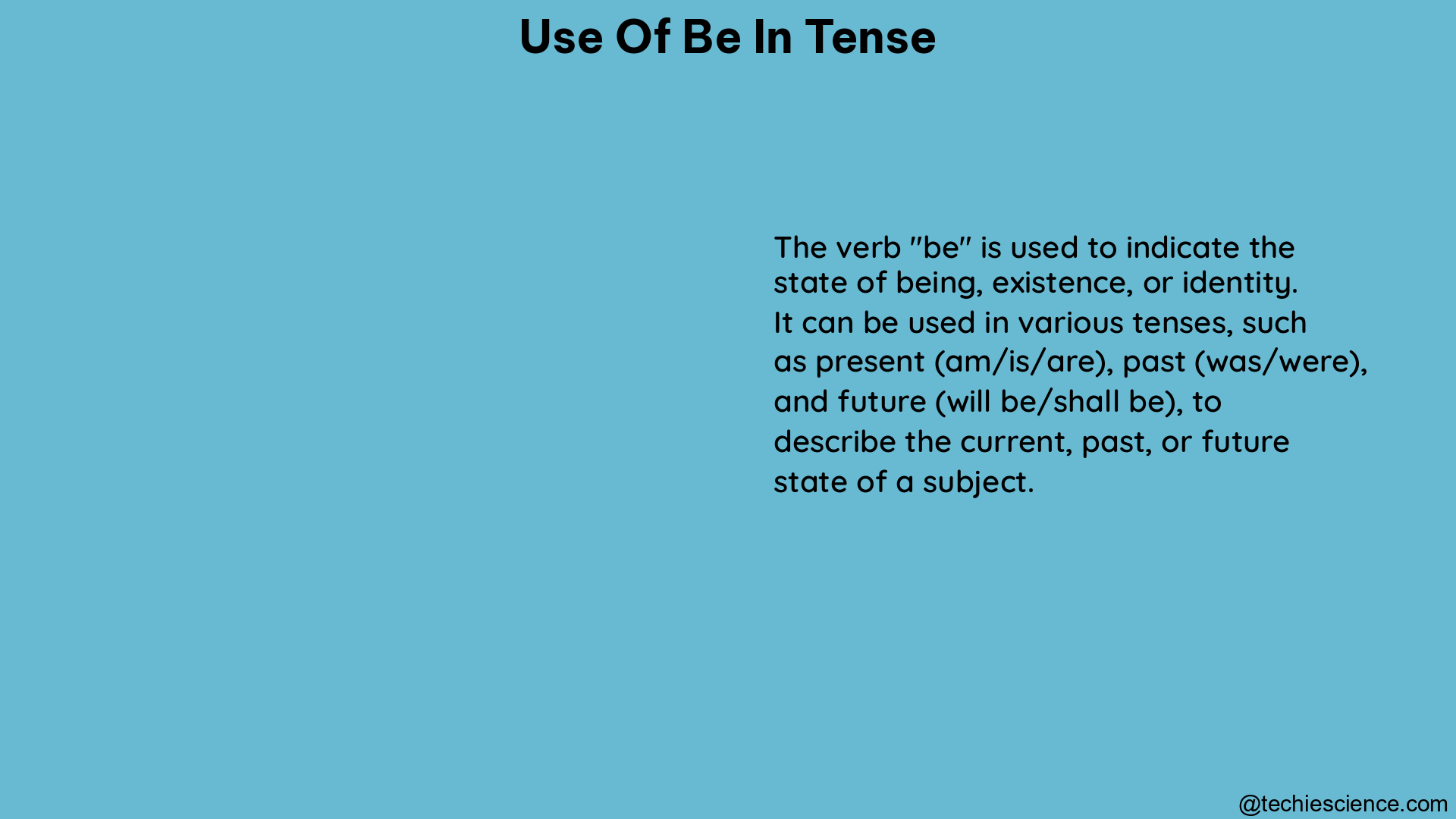The verb “to be” is one of the most fundamental and versatile verbs in the English language. It is used to express a wide range of meanings, from describing states of being to forming the passive voice. Understanding the proper usage of “to be” in different tenses is crucial for mastering English grammar. In this comprehensive guide, we will delve into the intricacies of using “to be” in various tense forms, providing detailed explanations and examples to help you become a proficient English speaker.
Present Tense
Affirmative Form
The affirmative form of “to be” in the present tense is as follows:
| Subject | Verb |
|---|---|
| I | am |
| You | are |
| He/She/It | is |
| We | are |
| You | are |
| They | are |
Examples:
– I am from New Zealand.
– You are Chilean.
– He is twenty years old.
– She is a nurse.
– It is a big dog.
– We are intelligent.
– You are students.
– They are married.
Contractions
The contracted forms of “to be” in the present tense are:
| Subject | Contraction |
|---|---|
| I am | I’m |
| You are | You’re |
| He is | He’s |
| She is | She’s |
| It is | It’s |
| We are | We’re |
| You are | You’re |
| They are | They’re |
Examples:
– I’m from New Zealand.
– You’re Chilean.
– He’s twenty years old.
– She’s a nurse.
– It’s a big dog.
– We’re intelligent.
– You’re students.
– They’re married.
Negative Form
The negative form of “to be” in the present tense is:
| Subject | Negative |
|---|---|
| I am not | I’m not |
| You are not | You’re not |
| He is not | He’s not |
| She is not | She’s not |
| It is not | It’s not |
| We are not | We’re not |
| You are not | You’re not |
| They are not | They’re not |
Examples:
– I’m not from Spain.
– You’re not Australian.
– He’s not thirty years old.
– She’s not a teacher.
– It’s not a big dog.
– We’re not intelligent.
– You’re not students.
– They’re not married.
Past Tense

Affirmative Form
The affirmative form of “to be” in the past tense is:
| Subject | Verb |
|---|---|
| I | was |
| You | were |
| He/She/It | was |
| We | were |
| You | were |
| They | were |
Examples:
– I was from New Zealand.
– You were Chilean.
– He was twenty years old.
– She was a nurse.
– It was a big dog.
– We were intelligent.
– You were students.
– They were married.
Negative Form
The negative form of “to be” in the past tense is:
| Subject | Negative |
|---|---|
| I was not | I wasn’t |
| You were not | You weren’t |
| He was not | He wasn’t |
| She was not | She wasn’t |
| It was not | It wasn’t |
| We were not | We weren’t |
| You were not | You weren’t |
| They were not | They weren’t |
Examples:
– I wasn’t from Spain.
– You weren’t Australian.
– He wasn’t thirty years old.
– She wasn’t a teacher.
– It wasn’t a big dog.
– We weren’t intelligent.
– You weren’t students.
– They weren’t married.
Other Tenses and Forms
Infinitive
The infinitive form of “to be” is:
– to be
Present Participle
The present participle form of “to be” is:
– being
Past Participle
The past participle form of “to be” is:
– been
Word Order
The typical word order when using “to be” in a sentence is:
– Subject + Verb + Object
– I am a student.
– You are a doctor.
– She is a teacher.
– We are engineers.
– They are lawyers.
Negative Sentences
To form negative sentences with “to be”, you can use the word “not”:
– I am not a student.
– You are not a doctor.
– She is not a teacher.
– We are not engineers.
– They are not lawyers.
You can also use contractions with “not”:
– I’m not a student.
– You’re not a doctor.
– She’s not a teacher.
– We’re not engineers.
– They’re not lawyers.
Imperative Form
The imperative form of “to be” is used to give commands or instructions:
– Be quiet.
– Be careful.
Using “To Be” with Modal Verbs
“To be” can be used with modal verbs to express various meanings:
– With “will”:
– It will be dark soon.
– They might be tired.
Using “To Be” with Nouns, Adjectives, and Prepositional Phrases
“To be” can be used with different types of phrases:
– With a noun phrase:
– My mother is a teacher.
– Bill Clinton was the president of the US.
– With an adjective:
– This soup is very tasty.
– The children were good.
– With a prepositional phrase:
– John and his wife are from Manchester.
– The flowers are on the table.
Continuous Tenses
“To be” is used in continuous tense forms to express ongoing actions:
– Present Continuous:
– I am being very helpful.
– We are being very careful.
– Past Continuous:
– I was being very helpful.
– We were being very careful.
Passive Form
“To be” is used in the passive voice, along with the past participle of the main verb:
– The flowers are being watered.
– The house was being painted.
Question Form
To form questions using “to be”, the verb is moved to the beginning of the sentence:
– Am I a student?
– Are you a doctor?
– Is she a teacher?
– Are we engineers?
– Are they lawyers?
Practice Exercises
Practice using “to be” in different tenses and forms by writing sentences with the following expressions:
– To be glad
– To be busy
– To be married
– To be single
– To be lucky
– To be ready (for)
Reference Links
- https://www.grammar.cl/Present/To_Be.htm
- https://preply.com/en/blog/using-the-verb-to-be-in-present-simple-tense/
- https://learnenglish.britishcouncil.org/grammar/english-grammar-reference/verb-be
- https://grammar.collinsdictionary.com/us/easy-learning/how-do-you-use-the-verb-be-in-english
- https://languagetool.org/insights/post/forms-of-to-be/

Hi…. I am Goutam Datta. I have completed a double M. A. in English and B. Ed. I am a creative writer. Currently, I am a part of the LambdaGeeks.